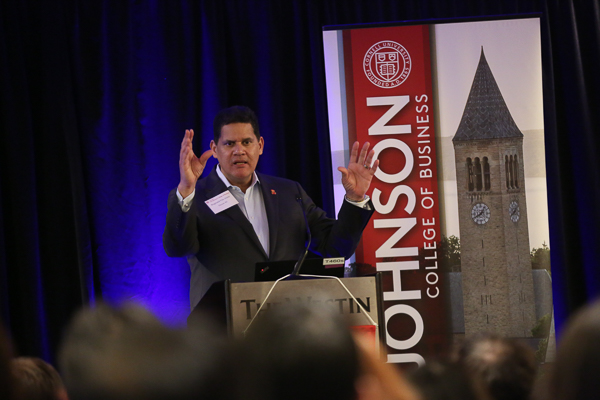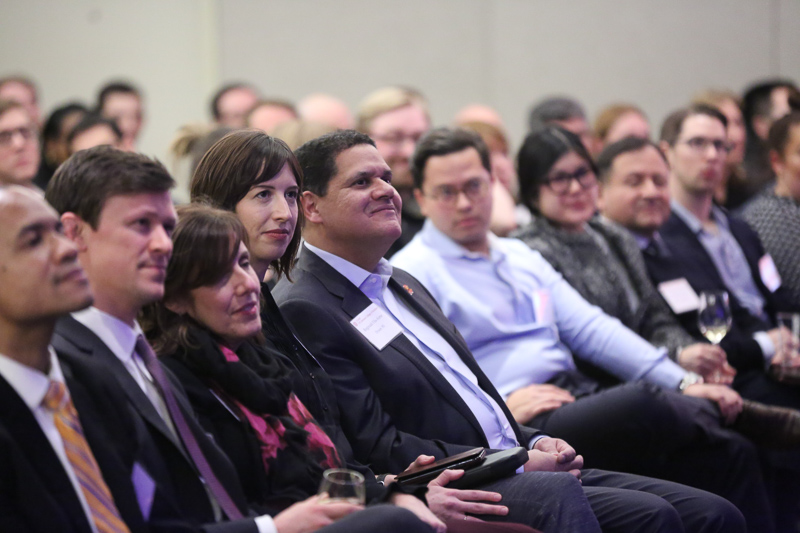Making people smile: Reggie Fils-Aime ’83 shares the driving force behind innovation at Nintendo

From the epic quests at the center of The Legend of Zelda, to the heart-stopping races in Mario Kart, Nintendo has introduced a cast of timeless video game characters and imaginative storylines that have transcended generations.
But the company has never rested on its laurels, Reggie Fils-Aime ’83 (Dyson School), president and chief operating officer at Nintendo, said in a keynote presentation titled The Innovator’s Rulebook For Breaking the Rules, at the Cornell Business Forum, an alumni event hosted by the Cornell SC Johnson College of Business. Instead, Nintendo constantly looks for new ways to reinvent old favorites, build revolutionary gaming hardware, and deliver unique entertainment experiences to its loyal fans.

While the gaming giant consistently succeeds in its mission to entertain and delight, being a nimble innovator isn’t easy for a company with more than 100 years of history. Their secret? At Nintendo, Fils-Aime explained, innovation means not only breaking the mold and introducing new games, characters, and consoles, but also staying true to the brand’s identity and core mission—putting smiles on people faces.
Innovation is a journey, not a destination
For Fils-Aime, finding creative ways around obstacles has been a thread that has permeated his career, preparing him little by little for his current role, which he calls the “opportunity of a lifetime.”
Early on, Fils-Aime worked at Guinness, where he was tasked with identifying ways to bring the pub experience that patrons expected from the brand to the home market. In other words, that creamy taste that had long differentiated Guinness from its competitors now had to—literally—be bottled. Guinness’ breakthrough came when their team of researchers and developers created a widget that released nitrogen into bottled and canned beer and brought that favorite Guinness foam to the desired level.
When Fils-Aime later accepted a position at Panda Express, he was once again tasked with overcoming a challenge that required an out-of-the-box solution. A staple eatery at malls around the country, Panda Express knew it needed to expand its reach beyond that environment to continue to grow its brand and reputation. But the menu, portions, and house operations had to evolve in order for the restaurant to succeed on a street corner rather than in a mall.
“Just like with Guinness, the key was innovating while maintaining that brand essence,” Fils-Aime explains. “In both cases, we had to change the delivery method while maintaining that quality that people expected.”
By the time Fils-Aime came to Nintendo, he was well-versed in innovation, but the organization was an entirely different animal compared to any other place that he had previously worked. Even back in 1889, when the company was founded as a manufacturer of decorated playing cards in Japan, it was already itching to disrupt the market. It was the first, for example, to have its cards be coated in plastic and the first to feature Western intellectual property on its cards.
Fast forward to modern-day Nintendo, and that drive for innovation remains. Though the company has the largest number of video game characters and franchises than any other brand in the world, its greatest challenge is to continue to deliver these classic characters in ways that surprise people.
“Fans look forward to sequels, and our developers are always trying to deliver something that’s unprecedented. As soon as we create new franchises, we are challenged for sequels and new games. It drives our creators to challenge conventional wisdoms and break their own rules,” Fils-Aime said.
That’s why for its latest iteration of The Legend of Zelda, Nintendo veered away from the traditionally well-defined game universe that kept players on a predetermined path in favor of a more open-world approach where players could choose their own journeys. Though there was much more freedom and the game felt very different than previous versions, players still had to rely on strategies from past series. The Legend of Zelda series is Fils-Aime’s favorite Nintendo franchise, he said, and so he was particularly pleased when this innovative iteration became one of the highest rated in history with more than 11 million copies sold.
The rulebook for breaking the rules
Though the company has an impressive track record, not every risk that Nintendo has taken has been a success, but Fils-Aime said neither he nor the rest of his team are afraid to admit it. The introduction of the Wii U console, for example, was met with heavy criticism and resistance, and for all intents and purposes, the product was a failure compared to the iconic Game Boy or Wii.
Still, Fils-Aime said the Wii U experience taught the team a great deal, empowering them to keep pushing innovation forward. Without the “failure,” of the Wii U, the team may have never introduced the Nintendo Switch, which became Nintendo’s highest selling system to be sold during the holiday season.
“The Wii U allowed players to switch between a tablet experience and a large, main screen in their living room, but the problem with it was that the tablet stopped working once the player moved too far away from the main console, which was connected to the television. We learned, however, that people loved the idea of transferring the game between two screens, and that insight helped lead to the Nintendo Switch,” Fils-Aime explained.

For people who love playing video games, the concept of never having to stop has proven incredibly powerful, Fils-Aime explained, admitting that he, too, has spent many long nights immersed in a game he just couldn’t put down. That’s why the Nintendo Switch, which features attached controllers that can detach from the portable console and be used on their own while the console is docked to the TV, has been a success, he insists.
“Some companies prefer to reinvent existing formulas. They think: if it’s working, why tinker with it? But as Satoru Iwata famously said at a conference, ‘At Nintendo, we don’t run from risk, we run to it.’”
Not being afraid to take risks has driven the company to innovate even beyond the world of traditional gaming with the introduction of Nintendo Labo. Nintendo Labo kits are an extension of the Nintendo Switch console and provide players with tools and technology to make “do-it-yourself” creations. Using modular sheets of cardboard designed to interact with the Nintendo Switch, players can create their own mix of different digital and creative experiences, from a piano to a robot. Thanks to a partnership with the Institute of Play, the system has been introduced to 100 schools in the United States, with many more schools on the waiting list.
What’s next for Nintendo
A household name recognized around the world, Nintendo has reached a peak that most brands only dream of—yet it shows no sign of slowing down. Always paying attention to the biggest trends in its space, Nintendo jumps in when the timing and the opportunity are right. As it continues to focus on its core gaming business, it has, for example, also ventured into the world of mobile gaming, introducing games like Super Mario Run, developed strictly for the mobile environment. One day, Fils-Aime said, the company hopes to see its mobile gaming revenue become comparable to its video game revenue.
Though it has its finger on the pulse of the industry, Nintendo doesn’t, however, conform to its competition or other pressures. While many of its competitors are perfecting their combat games with new weapons and missions, Nintendo stays true to itself and to the diverse demographic it serves. Its answer to the biggest shooting games of the day? Splatoon—a “shooting” game where characters shoot paint in an effort to cover the biggest surface area and transform into squids to travel across the ink. It’s colorful, entertaining, and appeals to players young and old alike.
Similarly, when asked why Nintendo hasn’t yet entered the cloud gaming space or made its games available across a wider range of devices like some of its competitors, Fils-Aime pointed the audience to the very thing that makes Nintendo the brand it is today: Mario, Princess Peach, Link, and the rest of the intellectual property that propels the company forward. This IP is a key business pillar for the company, which is why it’s currently investing in an animated Mario film in collaboration with Illumination, an attraction at Universal Studios and, of course, merchandise. Plus, he pointed out, the best way to create gaming experiences is to do it with a foundational understanding of the hardware system it’s played on. “You couldn’t play Wii Sports on a PlayStation 2,” he said.
As Fils-Aime’s presentation came to a close and the discussion was opened up for questions, many in the crowd asked him how he arrived at Nintendo and how he overcomes the challenges he faces in his role today. For him, he said, joining the company and working through its daily obstacles comes down to sharing in Nintendo’s ultimate goal of making people smile, which it manages to do on a daily basis.
“Long before I joined Nintendo, I would play The Legend of Zelda with my son. We were both working on beating the game and then one night I came home to screaming and just pure joy, and I knew he had finally done it,” Fils-Aime recalled. “That feeling and that sight has stayed with me through all these years.”


Comments